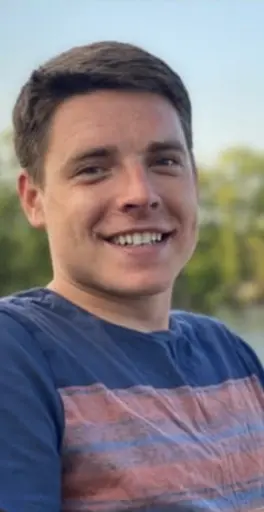For many undergraduates, a semester or two of working in a professor’s research group is a great way to learn their way around a lab and burnish their resumes or grad school applications. But the experience of two undergraduate chemical engineering majors at the University of Wisconsin-Madison was a little more intense: both made major contributions to a project developing a new technique for recycling multilayer plastic, earning them coauthor credits on a paper in the Nov. 20, 2020, issue of Science Advances.
 Jesse Banick
Jesse Banick
Jesse Banick signed up for a semester of independent study in the winter of 2019 to cap off his degree in chemical engineering with a certificate in engineering for energy sustainability. A previous co-op at the Neenah, Wisconsin-based plastic packaging company Bemis, recently acquired by Amcor, led to his interest in multi-layer plastics, and in particular ways to recycle them.
Banick wanted to investigate whether solvent-based reactions could be used to separate and recover polymers from the multilayer thermal plastics used in food and medical supply packaging. One-hundred-million tons of those plastics are produced each year, and they are almost impossible to recycle using current commercial methods because it’s difficult to separate the bonded layers.
He brought his idea to UW-Madison catalysis expert George Huber, Richard L. Antoine Professor in chemical and biological engineering. Huber and other UW engineers have pioneered solvent-based reactions to convert biomass—like wood and agricultural waste—into useful chemicals and biofuel precursors. Huber was intrigued by the idea of using some of the same principles to separate plastics and tasked grad student Ted Walker to oversee the project.
“The question was whether we could leverage our understanding of solvent effects to deconstruct multi-layer plastics,” says Walker, who earned his PhD in chemical engineering in 2019. “Because if we could do that, at least in part, it would solve one of the big technical hurdles in recycling plastic.”
Walker assigned the experimental part of the project to another undergraduate, Nathan Frelka, who earned his bachelor’s degree in chemical engineering from the University of Wisconsin-Madison in 2019.
 Nathan Frelka
Nathan Frelka
At that point, Frelka had worked in Huber’s lab for several months, and Walker was confident he had developed the skills and knowledge to tackle the task on his own.
Frelka ran with the assignment.
His first hurdle was narrowing down the number of candidate solvents that could dissolve the individual layers of film. “It was a lab that’s focused on solvent effects, so our options were huge,” Frelka says. “Just trying every solvent available was impossible.”
That’s why he began to painstakingly assess potential solvents using Hansen Solubility Parameters, a predictive tool. He eventually identified a set of solvents he believed could dissolve the individual elements of a three-polymer plastic he was working with.
Frelka designed his experimental apparatus and tested mixed pellets of the polymer using the solvents he’d identified. The experiment worked, with the solvent washes selectively dissolving the target polymers which could then be recovered. The next step was to try the process on the three-layer commercial plastics themselves. “It was pretty exciting; the proof of concept on the pellets translated really well to the plastic,” says Frelka.
Those experiments are now part of the proof of concept behind the Solvent-Targeted Recovery and Precipitation, or STRAP processing technique, being developed by Huber and colleague Reid Van Lehn, the Conway Assistant Professor in chemical and biological engineering. Van Lehn is using even more powerful computational tools to identify candidate solvents—hoping eventually to be able to recycle plastics with 10 or more layers using a series of solvent washes to recover the polymers, which can then be used to make new plastic products.
 Ted Walker
Ted Walker
The STRAP process is being developed even further as part of the Department of Energy-funded Multi-University Center for the Upcycling of Plastic Waste, directed by Huber
“This really exemplifies the best-case scenario for an undergraduate researcher,” says Walker. “Nate proposed and managed a set of experiments with almost no oversight. And in that first pass of experiments, he was able to demonstrate something that had not been done before.”
Jesse Banick now works as a research and development engineer at Amcor. “Once the paper was published, I sent it to every family member and then some,” he says. “I was amazed that the work I contributed to in an independent study in my final semester was now a part of a center that was awarded $10 million. That was very rewarding!”
Frelka is currently a product development engineer at Charter Next Generation in Milton, Wisconsin. He is no longer investigating plastic recycling but says his research experience at UW-Madison is still valuable. “I learned through the experience and from Ted and Professor Huber how to think about a problem and dive into it,” he says. “I apply that process and way of approaching things every day.”